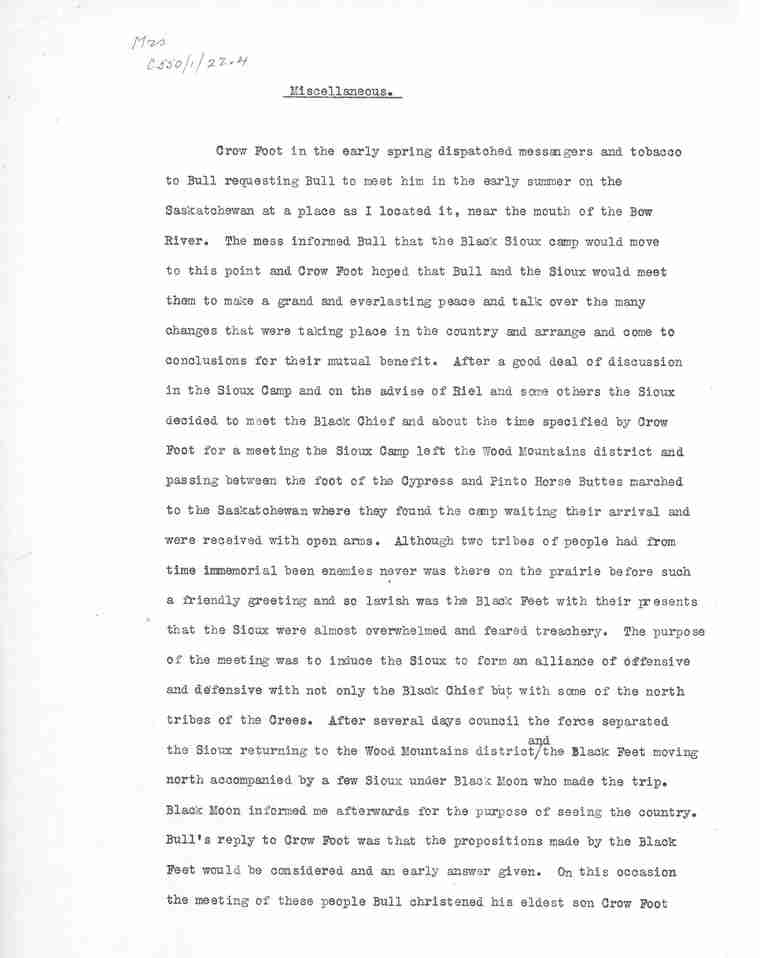James Walsh Papers - Miscellaneous
 | ||
| Database ID | 26269 | |
| Institution | University of Saskatchewan Libraries Special Collections | |
| Fonds/Collection | Morton Manuscripts Collection | |
| Series | MSS-C550 | |
| File/Item Reference | MSS-C550-1-22-4 (Box 35) | |
| Date of creation | n.d. | |
| Physical description/extent | 1 folder; .5 mm of textual records | |
| Number of images | 3 | |
| Historical note | James Morrow Walsh (22 May 1840 - 25 July 1905) was a North West Mounted Police (NWMP) officer and the first Commissioner of the Yukon Territory. Born in Prescott, Ontario, James Walsh was one of the original officers of the NWMP. Superintendent Walsh was assigned in 1875 to establish a post in the Cypress Hills in what is now Saskatchewan. He named it Fort Walsh after himself. The location of the post was determined by the Cypress Hills Massacre in 1873, an atrocity stemming from the illegal whiskey trade. Walsh's original role was to shut down this trade, but in June 1876 his position grew in importance when several thousand Sioux crossed the border into Canada, taking refuge there after the Battle of Little Big Horn. They settled near the Wood Mountain post in present-day Saskatchewan.Walsh developed a strong friendship with the famous Sioux leader Sitting Bull and successfully kept peace in the region. By the summer of 1877, Walsh, although still in command of Fort Walsh, spent little time there. His headquarters became the Wood Mountain post, among Sitting Bull and 5,000 Sioux. During this time, Walsh became famous in the American press as "Sitting Bull's Boss." In reality, Walsh was unable to fulfill his orders to convince Sitting Bull to return to the U.S. The Canadian government decided that Walsh's friendship with Sitting Bull was an obstacle to the Sioux's return to the United States, and in 1880 he was transferred to Fort Qu'Appelle, Saskatchewan. Soon after, he took health leave and returned to Ontario. He reluctantly resigned his commission three years later.In August 1897, during the height of the Klondike Gold Rush, Walsh was appointed Commissioner of the newly-created Yukon Territory. He resigned soon after in 1898. He died in Brockville, Ontario in 1905. | |
| Scope and content | This account by James Walsh is a brief description of how he 'succeeded in undoing' what Louis Riel had done to form a federation of the Indians and Metis of the Canadian prairies in 1877-1879. | |
| Restrictions on access | There are no restrictions on access. | |
| Contributer | Walsh, James (author) | |
| Copyright holder | Public domain | |
| Copyright expiry date | Public domain | |
| Other terms governing use and reproduction | Responsibility regarding questions of copyright that may arise in the use of any images is assumed by the researcher. | |
| Type | Archival | |
| Primary Media | Textual documents | |
| Provenance Access Point | Morton, A.S. | |
| Other notes | See longer version in Special Collections: MSS-C550-1-23.4. | |
| Treaty boundaries | Treaty 4 Treaty 6 International | |
| Cultural region | Plains | |
| Names | Crowfoot, ca. 1830-1890 (Chief) isapo-muxika Riel, Louis, 1844-1885 Sitting Bull, 1831-1890 (Chief) Ta-tanka-i-yotank takwanÄw kÄ-apit Walsh, James Morrow, 1840-1905 | |
| Subject | Chiefs International relations Law Enforcement -- NWMP Metis Dakota (Sioux) Blackfoot Confederacy - Siksika (Blackfoot proper) | |
| Date Range(s) | 1870-1879 | |
| Permanent Link | https://digital.scaa.sk.ca/ourlegacy/permalink/26269 |
|
